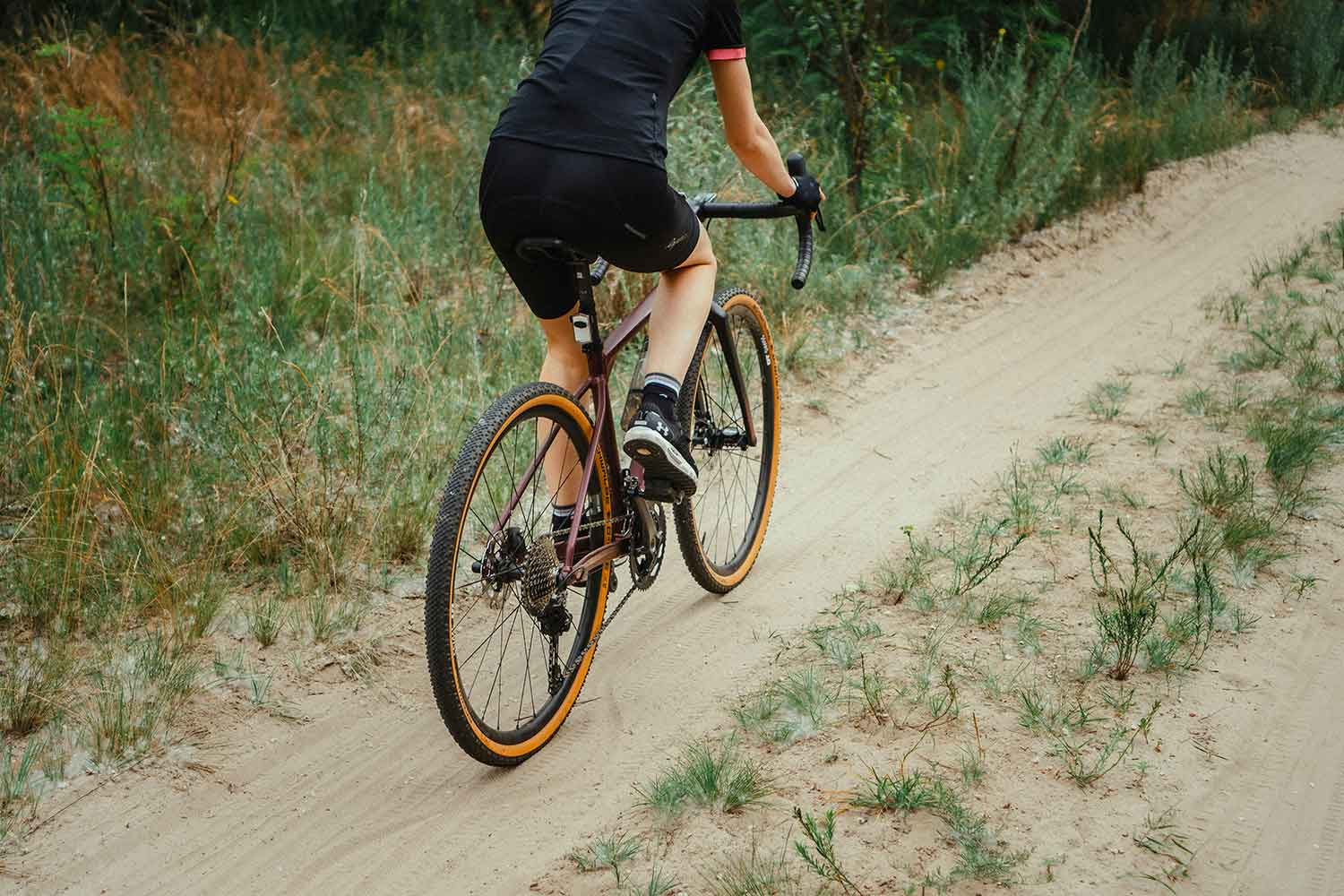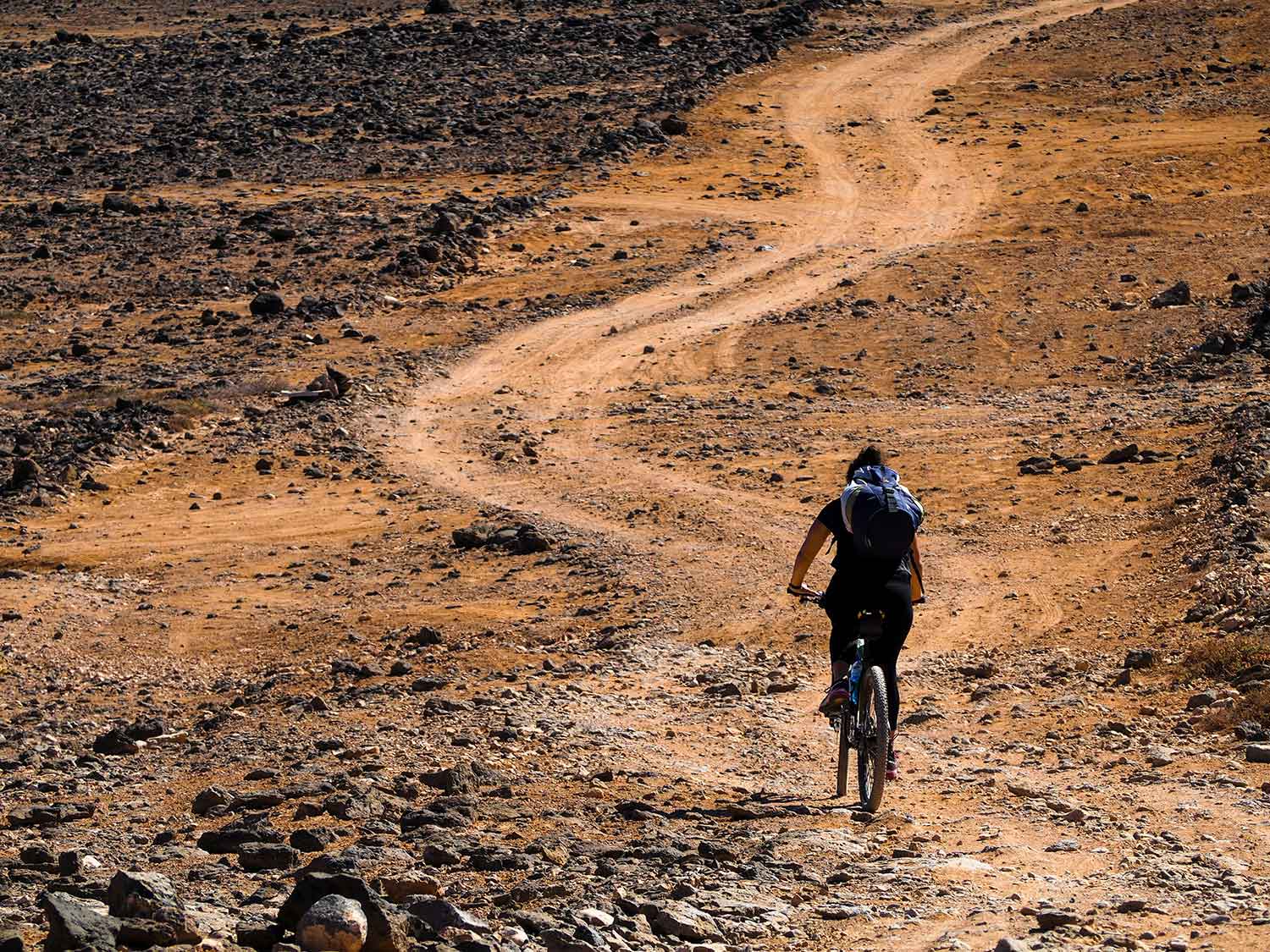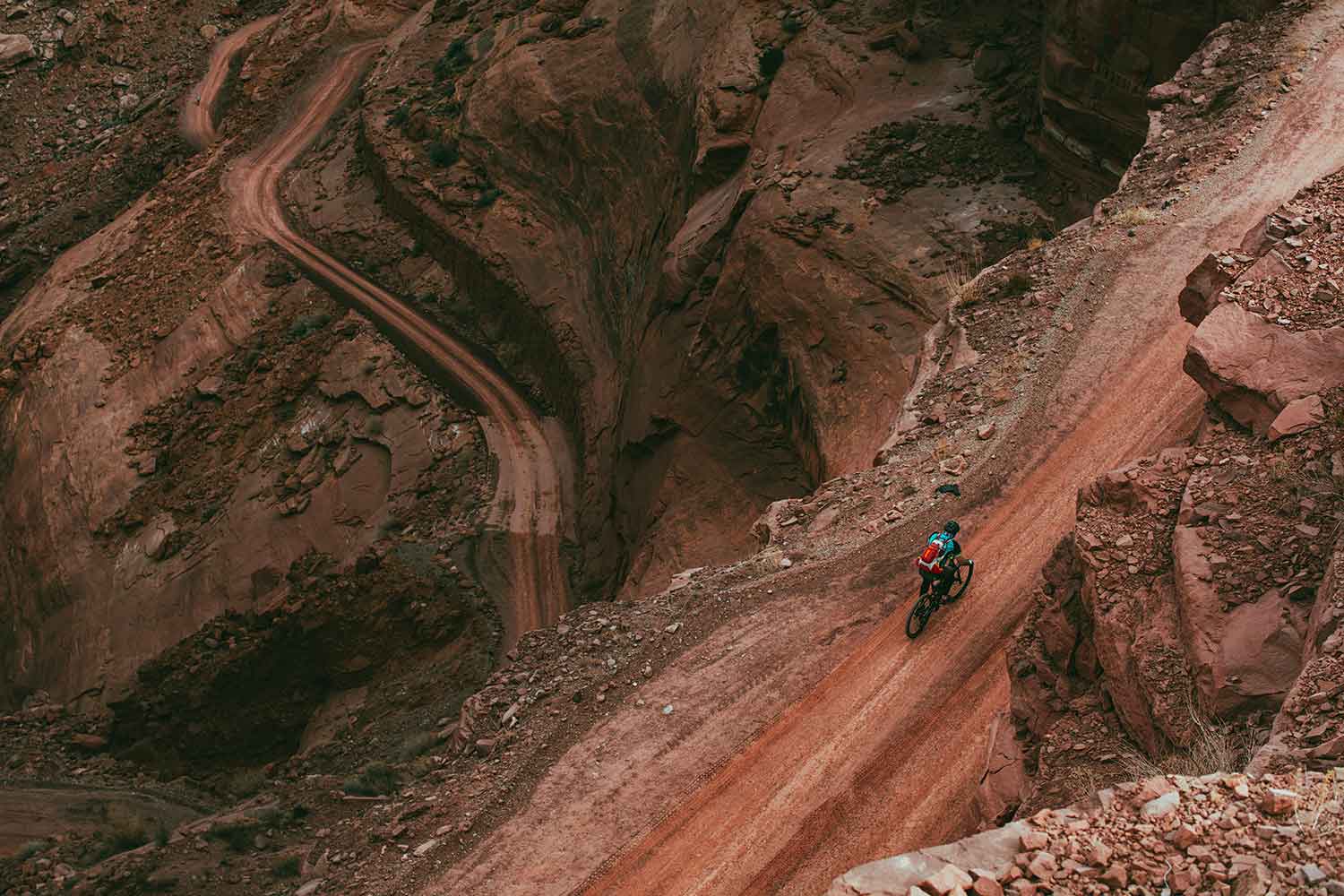Have you ever found yourself eyeing the gravel trails beside your usual road cycling routes and wondering if your trusty road bike could take on the challenge?
If so, you’re not alone!
Many cycling enthusiasts are keen to explore the versatility of their road bikes by venturing onto gravel paths, blending the thrill of road rides with the challenge of rough gravel.
In this guide, we’ll dive into the possibility of fitting gravel tires on a road bike, transforming it into a gravel-friendly machine, and what you need to consider before hitting new paths.
A Word For Those Skeptical About The Gravel Biking Trend And Wondering If It’s All Just A Clever Marketing Ploy
I have written a short piece of text that dives deep into the substance behind the hype. My article addresses common doubts and sheds light on the genuine appeal of gravel biking. Join me in unraveling the truth behind gravel bikes and decide for yourself if they truly redefine cycling or are simply a product of marketing genius.
But if you are truly here to see how you can convert a road bike to a gravel bike, keep on reading !
Embracing the Gravel: Transforming Your Road Ride for the Unbeaten Path

As the line between road rides and the allure of dirt and gravel tracks blurs, the cycling world has seen an evolution towards more versatile setups. Gravel-specific bikes and bike conversions have become the bridge for cyclists eager to explore beyond the smooth tarmac without committing to buying a new bike.
But what if your modern road bike could join you on these adventures?
This introduction to gravel riding and bike finder guide delves into the key differences between road and gravel biking, focusing on how a road bike frame, when equipped with wider gravel tires like the legendary Corsa road racing tire or its more robust, nylon-casing version, can adapt to the demands of rough gravel and loose terrain.
Gravel bikes are designed around the concept of versatility, with features like wide tires and 700c wheels to handle a mix of technical gravel and fast-rolling pavement.
However, with the right bike conversion, your current road bike doesn’t have to sit out the fun. By choosing tires carefully—considering options like the pro-level race Strada tires for their clincher and tubeless versions—you can transform your road bike into a capable companion for gravel tracks.
The move to wider, more robust tires, such as a 28mm or larger, is essential in navigating the differences between road and gravel surfaces, providing the necessary grip and durability for mixed terrain.
Modern gravel riding demands a bike that’s a bit more robust to handle everything from smooth tarmac to technical, loose gravel. With sales and offerings from top brands like Revel, Kona, Look, and Liv Bikes, finding components for a converted road bike is more accessible than ever.
Whether you’re rolling on Mavic wheels or considering the tubeless convenience for your gravel setup, the aim is to create a bike that’s versatile enough to roll fast on pavement yet rugged enough to tackle the unpredictable nature of gravel.
As we take a closer look at converting a road bike for gravel, remember that the right upgrades can make all the difference. From the choice of tires to the nuances of bike geometry, the transition from like-road to gravel-ready is an exciting journey.
With this guide, you’re equipped to navigate the path from a traditional road setup to a gravel-adventuring machine, ensuring your ride is prepared for whatever type of terrain lies ahead.
What About Bike Tyres : Can I Just Put Gravel Tires on My Road Bike?
The short answer is:
“Yes, but with some considerations.”
Swapping out your road tires for gravel-specific ones is the first step towards making your road bike gravel-ready. However, it’s crucial to check your bike’s frame and fork clearance.
Gravel tires are generally wider than standard road tires, and not all road bikes have the necessary clearance to accommodate them. If there’s enough space around the brakes and fork, then you’re good to proceed. Remember to measure carefully to avoid any rubbing issues! We’ll get back to that in a minute.
But for now, let’s talk about:
Transforming Your Road Bike into a Gravel Bike

Turning your road bike into a gravel bike involves more than just tire changes. Here are some adjustments you might consider:
- Tires and Wheels: Start with gravel-specific tires that offer more grip and are more puncture-resistant than typical road tires. If your budget allows, consider a set of wheels, possibly 28mm or wider, dedicated to your gravel adventures for an optimal bike conversion. This makes switching between road and gravel setups much easier.
- Gearing: Gravel riding often involves varied terrain, including steep climbs and rough gravel sections. You might find your road bike’s gearing too aggressive for comfortable gravel riding. Consider a cassette with a wider range to make those climbs more manageable. I give you more information about that further in the guide, including tips on gearing up for the transition between road racing and gravel riding.
- Handlebars: Gravel handlebars are wider and sometimes flared out at the bottom, offering more stability on uneven surfaces. If you’re serious about gravel riding, swapping to a gravel-specific handlebar can enhance control and comfort.
- Suspension and Seatpost: Some riders opt for a suspension fork or a shock-absorbing seatpost to improve comfort on bumpy gravel paths. These modifications can make a significant difference in ride quality but come with added weight and cost.
At This Point, If You’re Still Asking: Can You Ride Gravel on a Road Bike?
You now know the answer: Absolutely!
A road bike can handle well-maintained gravel paths, especially with the right tire setup, including possibly the widest tires for added stability.
The key is to adjust your riding style and your bike to the terrain. Take turns more cautiously, reduce your speed on descents, and maintain a relaxed grip on the handlebars to navigate through rough patches effectively, particularly when transitioning from road rides to dirt and gravel paths. It’s all about finding the balance between adventure, balance and safety.
Can I Use Road Wheels for Gravel?
Yes, you can use road wheels for gravel riding, but it’s essential to consider their durability and compatibility with wider tires.
Many modern road wheels can accommodate the wider gravel tires, but make sure they are robust enough to withstand the additional stresses of gravel riding.
Some riders prefer to invest in a separate set of gravel-specific wheels to avoid constant tire swaps and to ensure their wheels can endure the rigors of gravel paths.
Delving Deeper into Gravel Bike Tires, Road Tires and Bike Wheels for Gravel Adventures

When transforming your road bike for gravel, the tires and wheels are among the most crucial components to consider. The right choice can significantly enhance your bike’s performance and comfort on varied terrains.
Let’s explore the aspects of size, width, and compatibility in more detail to ensure you make the most out of this guide.
Tires: The Foundation of Gravel Riding
- Size Matters: Gravel tires come in a range of sizes, but the most common diameters are 700c (the standard for most road and gravel bikes) and 650b (a slightly smaller diameter offering a plusher ride). The choice between these sizes often depends on your bike’s clearance and your personal preference for ride feel.
- Width for Comfort and Grip: Gravel tire widths typically range from 30mm to 50mm. The wider the tire, the more comfort and traction you’ll have on loose or bumpy surfaces. However, the maximum tire width your bike can accommodate is limited by its frame and fork clearance. A good starting point for many riders is a tire width of around 35-40mm, offering a balance between performance and comfort without requiring extensive modifications to your road bike.
- Tread Pattern for the Terrain: The tread pattern on gravel tires can vary from minimal to aggressive. For well-maintained gravel paths, a tire with a minimal tread pattern might suffice, providing a smoother ride on paved sections while still offering enough grip on gravel. For more challenging or loose gravel surfaces, a tire with a more pronounced tread pattern will provide better traction.
Wheels: The Unsung Heroes of Gravel Riding
- Durability Is Key: Gravel riding subjects wheels to more stress than typical road cycling, especially when navigating through rocks, ruts, and potholes. Look for wheels built with durability in mind, often featuring more spokes and robust rim construction to withstand the irregular forces of gravel riding.
- Compatibility with Tire Width: Ensure your wheels are compatible with the width of your gravel tires. Most modern road bike wheels can accommodate tires up to 35mm wide, so make sure your bike can handle it. If you’re going for wider gravel tires, you might need wheels specifically designed for gravel or cyclocross bikes.
- Tubeless Ready: Many gravel riders prefer tubeless tires for their ability to run at lower pressures, enhancing traction and comfort while reducing the risk of punctures. If you’re considering going tubeless, make sure both your tires and wheels are tubeless-compatible.
Balancing Performance and Comfort To Enhance Your Gravel Experience
When choosing tires and wheels for gravel, it’s all about finding the right balance between performance and comfort:
Wider tires and durable wheels might add a bit of weight to your setup, but the gains in comfort, traction, and peace of mind on rough terrain are often well worth it.
Always remember to double-check your bike’s specifications for clearance and compatibility before making any purchases, and don’t hesitate to consult with a local bike shop for personalized advice based on your bike and the type of gravel riding you’re aiming to do. If you don’t feel confident enough to convert your road bike to a gravel bike, it is absolutely fine to just get professional help on it, utilizing a bike finder service for gravel-specific recommendations. By doing so, you will save time and money !
Essential Upgrades for an Optimal Gravel Experience : Gearing, Handlebars…
When venturing into gravel riding, we already said it, but upgrading specific components of your road bike can significantly improve your experience.
Let’s dive into the practical aspects of gearing, handlebars, and comfort-enhancing features to ensure your bike is gravel-ready.
Gearing: Tackling Varied Terrains
Gravel riding often involves a mix of steep climbs, long flats, and everything in between. Your road bike’s existing gearing might not offer the range you need for efficient and comfortable gravel riding.
- Wider Range Cassette with more chainrings can significantly improve performance on steep climbs during gravel rides.: Consider replacing your cassette with one that has a wider range. A cassette with a larger big cog (e.g., 32T or 34T) can make climbing easier. Ensure your rear derailleur can accommodate the larger cog size; you might need a long-cage derailleur.
- Compact or Sub-Compact Crankset: Swapping to a compact (50/34T) or sub-compact (48/32T or 46/30T) crankset can provide lower gearing options, making it easier to pedal through tough sections.
- 1x Drivetrain Conversion: Some riders opt for a 1x drivetrain setup (a single front chainring with a wide-range rear cassette) for simplicity and reduced weight. This setup eliminates the front derailleur and one chainring, relying on a wide-range cassette (e.g., 10-42T) to cover all necessary gears.
Handlebars: Enhanced Control and Comfort
The right handlebars can make a significant difference in handling and comfort on gravel.
- Wider Bars: Gravel handlebars, which are generally wider than road bars, offer better control on loose surfaces and are essential for maneuvering through dirt and gravel. A width increase of 2-4cm from your road setup can improve stability.
- Flared Drop Bars: These bars are wider at the drops, providing more control when descending on gravel. The flare allows for a more natural wrist position, which can enhance comfort during long rides, making it ideal for both road racing and rough gravel adventures.
- Bar Top Levers: Installing brake levers on the handlebar tops can offer additional braking positions, which is especially useful for technical sections where you might prefer to ride with your hands on the tops.
Comfort-Enhancing Components
Gravel roads can be rough, and adding comfort to your bike can make longer rides more enjoyable.
- Suspension Seatpost for bike conversion: These seatposts have built-in suspension that absorbs shock from rough terrain, significantly enhancing rear-end comfort. There are various types, from simple elastomer-based designs to more sophisticated hydraulic ones.
- Frame and Fork Compliance: While not an “upgrade” in the traditional sense, the natural compliance of your frame and fork plays a role in comfort. Carbon and high-quality steel frames can offer more compliance than aluminum. If you’re in the market for a new gravel-specific setup, consider this factor.
- Padded Bar Tape and Gloves: Double-wrapping your handlebars with padded tape or investing in quality padded cycling gloves can reduce hand fatigue on bumpy surfaces.
- Wider, Padded Saddle: A wider saddle with ample padding can provide better support for the more upright posture often adopted on gravel rides.
When considering these upgrades, think about the type of gravel riding you’ll be doing most often and prioritize the upgrades that will make the biggest difference for your comfort and enjoyment. Always ensure compatibility with your existing components and consult with a professional mechanic if you’re unsure about installation or suitability. With the right upgrades, your road bike can become a versatile gravel machine ready to tackle new adventures.
Integrating Suspension for a Smooth Gravel Ride
When converting a road bike for gravel use, incorporating some form of suspension can dramatically improve comfort and control on uneven terrain. However, adding suspension to a bike not originally designed for it comes with considerations. Let’s explore practical options for integrating suspension into your gravel setup.
Fork Upgrades
- Gravel-specific Suspension Forks: A few manufacturers offer lightweight suspension forks designed specifically for gravel bikes. These forks typically provide around 30-50mm of travel, enough to take the edge off rough terrain without the weight and bulk of a mountain bike fork. Keep in mind that changing the fork can alter the geometry and handling of your bike, so it’s essential to choose a fork with similar axle-to-crown length and rake as your current fork to maintain the bike’s intended handling characteristics.
- Lauf Grit Fork: An innovative option for adding suspension without a traditional spring system is the Lauf Grit fork. It uses leaf springs to provide about 30mm of travel, offering a significant reduction in vibration and small bumps. Its unique design and low maintenance make it a popular choice among gravel riders.
Seatpost Solutions
- Suspension Seatposts: For those not ready to change the fork, a suspension seatpost can be an effective way to add comfort to the rear of the bike. These posts typically offer 20-40mm of travel and can significantly reduce the impact of bumps and vibrations. Popular models include the Cane Creek Thudbuster and the Specialized CG-R seatpost, known for their reliability and effectiveness in smoothing out rough rides.
Frame and Wheel Considerations
- Frame Compliance: Some modern road and gravel frames are designed with built-in compliance, using carbon layup techniques or clever aluminum tubing shapes to offer a degree of shock absorption. While not “suspension” in the traditional sense, this built-in compliance can help smooth out road vibrations and small bumps.
- Wheels and Tires: While not a suspension component, the choice of wheels and tires, perhaps opting for Panaracer GravelKings, can significantly affect the ride quality for gravel riding. Wider rims paired with tubeless tires can be run at lower pressures, offering a natural form of “suspension” by absorbing impacts and conforming to the terrain. This setup can provide a noticeable improvement in comfort and traction on gravel surfaces.
Considerations Before Upgrading
- Compatibility and Geometry: Before adding suspension components, check the compatibility with your bike’s frame and existing components. Ensure that any new fork will work with your bike’s wheel size, brake type (disc or rim), and hub width. Also, consider how changes might affect your bike’s geometry and handling.
- Weight and Maintenance: Adding suspension components will increase the weight of your bike. While this might be a worthwhile trade-off for improved comfort and control, it’s something to keep in mind, especially for riders concerned about bike weight. Additionally, suspension components require regular maintenance to perform optimally, so be prepared for some additional upkeep.
Incorporating suspension into your gravel bike setup can transform your ride, making it more enjoyable and less fatiguing on rough terrain. Whether you opt for a suspension fork, a suspension seatpost, or both, ensure that the components you choose are compatible with your bike and suited to your riding style. With the right setup, you’ll be ready to tackle even the most challenging gravel roads with confidence and comfort.
Now, you might ask yourself :
Do I Need to Change Brakes When Converting My Road Bike to a Gravel Bike?

When converting a road bike to a gravel bike, whether you need to change the brakes largely depends on the type of brakes your road bike currently has and the conditions you expect to encounter on gravel.
Types of Brakes on Road Bikes
Rim Brakes
- Traditional Option: Many road bikes come equipped with rim brakes, which apply braking force directly to the rim of the wheel, but may not offer the best performance on dirt and gravel. While they are lightweight and efficient in dry, clean conditions, their performance can be compromised in wet or muddy conditions, common in gravel riding.
- Consideration for Conversion: If your road bike has rim brakes, you might find them less effective on gravel, especially in adverse weather. While it’s not strictly necessary to switch to disc brakes for casual or light gravel riding, for more serious off-road adventures, especially those involving mud and steep descents, disc brakes offer a significant advantage in terms of consistent stopping power and control.
Disc Brakes
- Increased Popularity: Disc brakes have become increasingly common on road bikes, especially those designed with gravel or mixed-terrain riding in mind. They offer superior braking in a wide range of conditions, including wet and muddy environments, and they don’t wear down the wheel rim.
- Gravel Conversion: If your road bike already has disc brakes, you’re in a good position for gravel riding. Disc brakes, especially hydraulic ones, provide the consistent and powerful braking needed for the varied and unpredictable terrain of gravel riding. In this case, you might not need to change your brakes for gravel use, although you may want to consider brake pad material or rotor size adjustments for optimal performance.
Factors to Consider
- Brake Pad Material: For gravel riding, you might want to opt for brake pads that are designed for durability and wet-weather performance. Sintered brake pads, for example, generally offer better performance in mixed conditions compared to organic pads.
- Rotor Size: Larger brake rotors offer more braking power, which can be beneficial on steep descents and challenging gravel terrain. If your road bike has disc brakes and you’re planning on tackling demanding gravel routes, consider upsizing your rotors for increased stopping power.
- Brake Clearance: For both rim and disc brakes, ensure there’s enough clearance for wider gravel tires. Limited clearance can lead to issues with mud and debris buildup, affecting braking performance.
- Mechanical vs. Hydraulic: If your road bike has mechanical disc brakes and you’re serious about gravel riding, you might consider upgrading to hydraulic disc brakes for their increased power and modulation. Hydraulic brakes offer better control and require less hand effort, which can be a significant advantage on long gravel rides.
In summary, while it’s possible to use rim brakes for gravel riding, especially in less demanding conditions, disc brakes are generally preferred for their consistent performance across a wide range of weather and terrain.
If your road bike already features disc brakes, you’re well-positioned for gravel conversion, possibly with only minor adjustments needed.
If you have rim brakes, consider how and where you plan to ride on gravel to decide if an upgrade to disc brakes is necessary for your enjoyment and safety, especially if you frequent both road rides and gravel paths.
Key Takeaways
- Check Clearance: Ensure your road bike has enough clearance for wider gravel tires.
- Consider Upgrades: Besides tires, think about gearing, handlebars, and comfort-enhancing components for a better gravel experience.
- Wheel Durability: Use durable wheels that can handle the demands of gravel riding, possibly investing in a gravel-specific set.
Diving into the world of gravel specific riding with your road bike opens up a new dimension of cycling adventures. With the right modifications and a bit of caution, you’ll discover the joy of exploring off-the-beaten-path trails. While road bikes are designed mostly for speed gravel bikes tend to offer more comfort and it’s a bit more robust on uneven roads.
Just remember, the transformation doesn’t have to be all or nothing.
Start with what’s most important—like tires—and gradually make adjustments as you get more comfortable with gravel riding.
Now, go ahead, gear up, and let the gravel adventures begin!
If you’ve been on the fence about the distinction between a traditional road bike and the increasingly popular gravel bikes, I hope that this guide gave you a closer look at the features that set them apart.
Top gravel bikes use specialized components tailored for the demands of off-road cycling, with a keen focus on tire technology. Unlike the standard 28mm tires commonly found on road bikes, gravel bikes often sport wider, more robust tires designed specifically for the unpredictable terrain of gravel paths.
Among the leading choices for gravel enthusiasts is the GravelKing series, renowned for its durability and versatility across a variety of surfaces. These tires embody the essence of gravel biking, offering a level of adaptability and resilience that traditional road bike tires simply can’t match.
Whether you’re navigating loose gravel or tackling rough trails, the transition to a gravel bike equipped with tires like the GravelKing can significantly enhance your riding experience, merging the worlds of road cycling and off-road adventure.



0 Comments